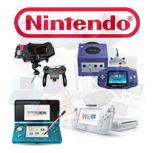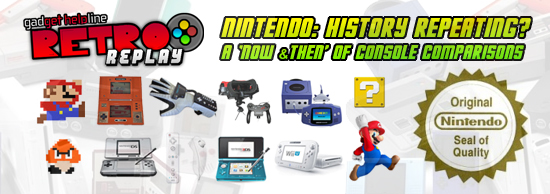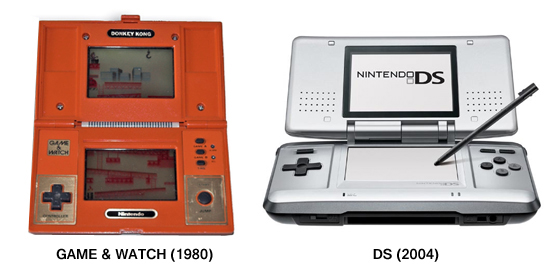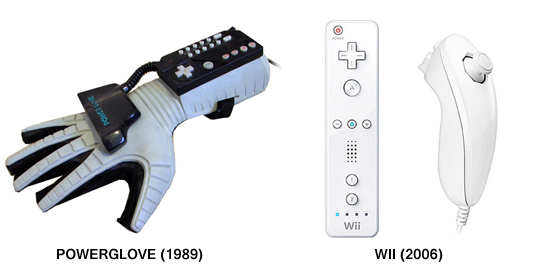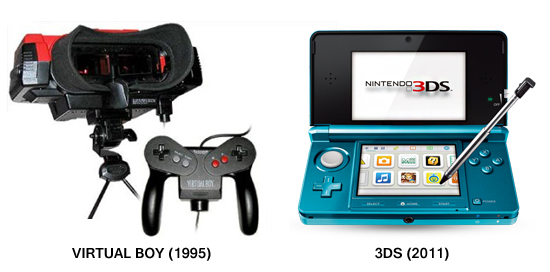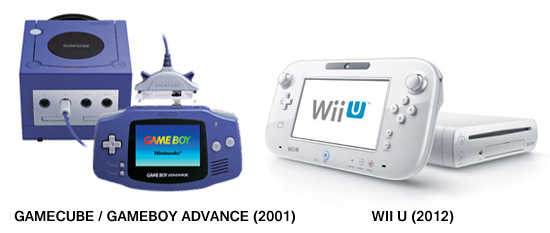Nintendo is hoping to repeat its success of Christmases past with the evolution of its popular Wii platform. The Wii U will arrive in the next few months – but the Gadget Helpline can’t help but think we might have seen something like this before. So in this very special RETRO REPLAY we’re going to take you back in time to see a few examples of when Nintendo has recycled its own ideas – sometimes to great acclaim, sometimes to epic fail. Prepare to get nostalgic!
THEN: GAME & WATCH (1980)
NOW: DS (2004)
CONCEPT: DUAL-SCREEN / CLAM-SHELL
Nintendo’s first solo step into the exciting realm of electronic entertainment (after starting up as a playing card company in the late 19th century) came with the Game & Watch series of the 80s. These early handheld models featured simplistic LCD display for gameplay and as the name would suggest the gadget would pull the dual role as a most unorthodox pocket watch. Some of gaming’s greats made early appearances on the many collectable Game & Watch titles (these units only featured one playable game and came before changeable cartridges and cards). Favourites included Super Mario Bros. and the Legend of Zelda but it was Donkey Kong that really changed the game.
The basic Game & Watch systems featured very simple button configuration and sprites were controlled by a left and right button. However the Donkey Kong version was the very first Nintendo system to introduce a ‘cross’ D-Pad which would carry on as a mainstay on the company’s hardware – even up to the very newest devices over 30 years later.
In retrospect, there is another factor that is now of equal importance for the handheld systems that would follow as the DK G&W was also the first Nintendo device to feature a hinged ‘clam-shell’ design. When opened, both the upper and lower sections featured a separate LCD display with the gameplay crossing over onto both.
This design and dual-screen function of the later Game & Watch pocket systems reappeared in 2004 with the arrival of the Nintendo DS that borrowed much from its ancestor and improved on the ideas first trialled in the Gameboy Advance SP which was also ‘clam-shell’ in format.
Introducing modern touchscreen technology the Nintendo DS portable’s lower second screen provided a platform in which gamers could interact with menus, maps and other features with either the provided stylus or with the touch of a finger. The comparisons between the Game & Watch and now classic DS system are undeniable and this is only the first occasion in which Nintendo would repeat itself.
THEN: POWER GLOVE (1989)
NOW: WII (2006)
CONCEPT: MOTION CONTROL
In 1989 Nintendo launched the Power Glove. On appearances alone it was an incredibly cool looking accessory for the Nintendo Entertainment System (NES) but sadly it was possibly one of the Japanese gaming co.’s biggest fails in terms on market potential. The gaming gauntlet (which had only two compatible titles) might however have paved the way for Nintendo’s greatest success – the Wii.
The Power Glove was actually designed and created by Mattel and was Nintendo’s first push (and the first by any games maker) to put players in control the action by physical motion and featured a traditional NES controller buttons on a forearm panel. In addition to the standard ‘A’ and ‘B’ buttons and a D-Pad the glove featured nine extra buttons to tweak commands with playable sprites including characters and vehicles controlled on screen by the wearer’s hand motions. Sadly these controls were deemed difficult to handle and the gadget was a commercial flop.
17 years later in 2006 Nintendo released the Wii home console – a primarily motion controlled system which used three dimensional movement capturing tech with LED and infrared detection in conjunction with a wireless handheld controller called a ‘Wiimote’.
The Wiimote featured the familiar Nintendo button configuration and could be used horizontally as a standard pad or for its true intended purpose – virtually anything! It could be wielded as a weapon, swung as a racket or as a golf club in a variety of fun and friend-play oriented games. The Wiimote snapped together with a Nunchuk accessory with thumbstick and trigger function for extra control on action or combat games and with additional peripherals such as the Balance Board the Wii has taken what the Power Glove had set out to do and two decades later has almost perfected it. To date the Nintendo Wii has sold around 45-million units in the United States. The Power Glove sold around 100-thousand – total.
Most of us in the U.K and Europe only ever got to see the mythical Power Glove in a movie called ‘The Wizard’ which starred Fred Savage. The film launched Super Mario Bros. 3 and was essentially a 90 minute long Nintendo advert – we loved it!
THEN: VIRTUAL BOY (1995)
NOW: 3DS (2011)
CONCEPT: 3D / PORTABLE
One of Nintendo’s most unusual offerings was the Virtual Boy released in 1995 which promised to “totally immerse players into their own private universe” with true 3D graphics. What it actually delivered was an eye-watering experience presented through a head mounted display similar to the Virtual Reality sets of the day. The graphics displayed on two layers in an aggressive red on black and the 3D was ropey and never truly representative of the quality of preceding Nintendo consoles which had by this time reached a brilliant 16-bit!
The Virtual Boy was lucky to claim that all-important Nintendo ‘Seal of Quality’ – it was that bad – and shifted only a few hundred-thousand units with only 22 available games. The ‘portable’ gaming gadget came with a stand for table top play and also with a control pad featuring two sizable hand grips – a design which became tweaked with the future Gamecube console and a shape that is noticeable again (if a little bit more natural) in the new Wii U Pro Pad. But it’s the concept of three-dimensional gameplay that Nintendo was attempting to get to grips with on this one, that added a blemish to its success streak . They dusted off and tried again in 2011 with the Nintendo 3DS.
The Nintendo 3DS was built up with much hype, combining the dual-screen format of the original DS (harking back to the Game & Watch) the handheld added a thumb-stick (one single thumb-stick) and reintroduced the exciting element of 3D which would make games pop out of the screen. This was an opportunity for Nintendo to make its mark as the first games system manufacturer to embrace the new wave of 3D with true full colour visuals without the usual headset or goggles.
The set up was perfect but the early sales were disappointing. This was largely attributed to the lack of a Super Mario Bros. title from day one and the headache inducing 3D which was criticised by parents and medical professionals – despite the fact that the portable coming with a toggle feature to adjust the intensity of the 3D layering. Poor press saw the console cost Nintendo almost all of what it made from the 3DS when the price drops hit and the console finally started to shift units in both the east and west markets. However, from a development point of view Nintendo’s 3DS is a massive leap forward from the Virtual Boy!
THEN: GAMECUBE / GAMEBOY ADVANCE (2001)
NOW: WII U (2012)
CONCEPT: SECOND SCREEN / HANDHELD CONNECTIVITY
In 2012 Nintendo will launch both its Wii U home console and a new revision to its current handheld with the 3DS XL. Little over ten years ago the games-maker did much the same with the release of the Gamecube and the Gameboy Advance which together would form Nintendo’s first product pairing which could be actively used in co-operation with one another.
Using a link cable the Gameboy Advance portable could be attached using the Gamecube’s controller port with the home system working as hub for downloading small and simple games to the handheld. But here’s the interesting part: Up to four GBA owners could hook up with link cables to be used to control games on the big screen or to play games on the portable screens with multiple players getting involved in the action. Starting to see the picture?
At this year’s E3 Expo Nintendo unveiled the final version of its Wii U – the ‘living room revolution’ which will not only bring the game to our television screens but will also deliver content to a wirelessly connected second touchscreen controller called a GamePad .
With the GamepPad players will be able to both take the action of certain games such as Super Mario Bros. U on the move as well as use the HD handheld tablet as an additional screen to display menus and maps in exciting Wii U optimised games such as Batman: Arkham City and Call of Duty: Black Ops II. Meaning we never need to pause or break from the game in progress. Multiplayer gaming also benefits from the addition of the second screen with one player taking a stronger role in the gameplay of titles like NintendoLand while additional players will use a Wiimote or Pro Pad.
We think these above examples show undeniable proof that Nintendo is not afraid to repeat itself – sometimes to mixed results but in general has seen continued success for Nintendo which has survived in an ever changing, ever advancing and ever-demanding gamer market.
Let us know your thoughts on our comments below or via our @Gadget_Helpline Twitter page or Official Facebook group.
